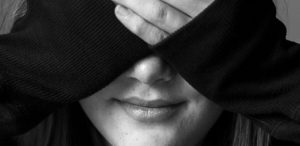Peeking through the keyhole
The bedroom door is shut. I’m supposed to be asleep already. I’m not quite sure what time it is but in the beds beside me my sisters have already fallen into a deep sleep. I hear voices coming from the living room. I can recognise my parents’ voices and hear another unfamiliar voice. I am standing closer to door trying to listen. It seems the sounds are getting closer but then getting away from me. I stand in front of the keyhole, covering one eye with my hand; another eye is wide open close to the keyhole trying to catch what is happening behind the closed door. I feel the tension in the air and not sure why. I don’t dare leave my room to check, so instead I’m hiding behind the door and checking what is happening through the keyhole.
Seeing without being seen. I feel the relief knowing that I have the freedom to look and check with the intensity that works for me, without feeling too exposed. I’m taking part of what is happening in the way I can contain. I collect fragments of information, images that are revealed to me, trying to create a story to fit the full missing picture. There is something comforting to be invisible. I have the freedom to stare without being interrupted, or to communicate. I know this feeling. I know it from a young age. The pleasant feeling of seeing and assuming I’m invisible.
My eyes are trained to catch fragments of images, expressions, facial movement. My ears are trained to catch the finesses of intonations, allusions of hidden resentment, pleasure or satisfaction. For years I sat and observed the world, not acknowledging that I am part of it and taking space and that I could also be seen and read.
When I first meet Daniel the memory of that young girl comes up. I remember the invisible girl who can see a lot. Daniel, a young man, is suffering from autism. He can communicate and is at a very low functioning level. He arrived to our meeting anxious and stressed. We sit on two couches opposite each other. Daniel avoids having eye contact with me. It stresses him out. I feel the tension he brought to the room. My breathing is tight and my body becomes alert. We sit opposite each other like two shy kids who are scared to ‘get caught’ by the other.
Daniel moves between his wish to be seen by me, to be acknowledged, and his wish to be invisible with me; longing to see and be unseen. We sit and instinctively I put my hands over my eyes covering them. I’m hiding my eyes and myself concurrently.

For several minutes we don’t say a word. I feel how gradually my breath is settled and how I am sinking into the darkness in my hands. I sink into the quietness. I feel the atmosphere in the room softening. Through my closed eyes I feel Daniel’s presence getting calmer. I create a crack, spreading two fingers and for a split of second our eyes connect. Daniel is shyly smiling and turns his head away. I take my hands down. I invite Daniel to talk to me. When it feels too much, we both know that we can hide behind our hands, and we can always ‘shut the door and peek through the keyhole’.
Beside the wish to be part of, to be seen and to be acknowledged, the world can sometimes be too much—too many sounds, too many eyes, too many feelings. The world can be overwhelming. Everything feels exposing and all I wish is to hide, but not to disappear. To still be in control and keep a thread of contact through an imaginative bubble, but, yet, so real. The choice to see and be unseen is a crucial stage before opening the door. Each one chooses his suitable keyhole.
The keyhole has number of qualities. It enables one to see and be unseen, but also helps to regulate and buffer the information we want to be exposed to. How much as therapists, consciously or unconsciously, do we use the techniques that Daniel and I created? I think of the therapists who wear makeup in the morning before entering the clinic to hide a long sleepless night, or therapists who spread a big smile on their face to hide pain and sadness that isn’t ready to be met by the world. Could it be that we, in our therapeutic position, are looking at the world and being supported by the keyhole?
My name is Yael Shahar. I’ve had intensive training in relational body psychotherapy, following my core training at the London School of Biodynamic Psychotherapy in the UK. I have also trained in early intervention for infants and young children on the autism spectrum, a job that relies on the attachment theory and therapy through interplay—Reciprocal Play Therapy. In addition to my work focused on the gay community in London, I worked around the issues of transgender, gender identity and sexual identity. I’m currently building my clinical practice and learning to deal with new dynamics that this place provides me. I believe that part of the therapeutic process is to offer a safe place where we can find our voice, the credo of our individual and personal commitment to act accordingly. I offer the space between us as a non-judgmental place of investigation and search for the truth that everyone holds in their heart.
I feel committed to the profession, and I find that hope and faith motivate me in my work.
For more information please visit my website at:
www.body-psychotherapist.com








